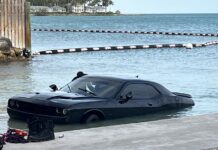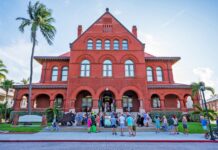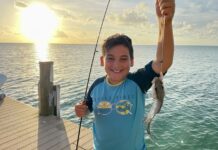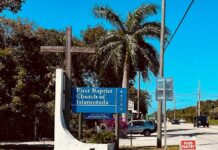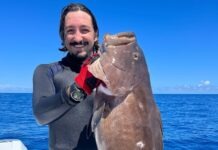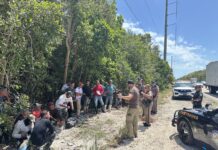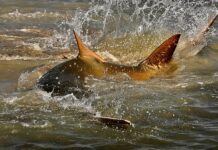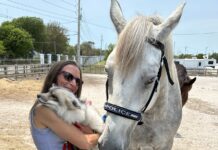
Big Pine Key is found a couple of islands south (or really west) of the Seven Mile Bridge, and is one of the Lower Keys. It is the second largest of the Florida Keys — only Key Largo is larger.
Unlike Key Largo and some other islands connected to the mainland by the Overseas Highway, Big Pine Key has remained relatively slow to develop, which is a good thing. While the gobs of high-end resorts have yet to arrive, it only seems like a matter of time before they do.
Big Pine is probably most famous for the Key deer, the alligators at the Blue Hole, and for being home to one of the last stands of slash pines in the Florida Keys. It is also the turnoff for the short drive to No Name Key, home to some fascinating Overseas Highway history, and an old brothel that is now home to the world-famous pub that greets visitors with a sign reading “You Found It.”
Technically, the No Name Pub is on Big Pine Key — but the pub, the highway and the deer are not the focal point of this Big Pine Key story. Later on, however, a Key deer does lend a leg. One of the things the island is not necessarily known for is that it was once home to a shark processing plant. The company, based out of New York, was called the Hydenoil Products Company.
While it might not be obvious at first glance, the name Hydenoil defines the primary products the company was making: hides and oil. The Hydenoil Products Company arrived in 1923. It was determined that sharks had several commercial uses. Primarily, for Hydenoil, the skin could be used to make leather, and the liver boiled down to produce oil. The plant also produced a pungent odor that rose from the mess and wafted across Big Pine Key (and No Name Key) like a big chum bag.
The plant is said to have been located where Bogie Channel flows between Big Pine and No Name Key. A Miami News article, dated Nov. 16, 1930 and headlined “Shark Industry is Lusty One,” described aspects of the operation. According to the writer, Cecil R. Warren, who interviewed the company’s Florida representative, Mr. Eddy, Hydenoil planned to establish shark processing plants up and down the Florida coastline.
By 1930, the Big Pine plant had processed 20,000 sharks, including sawfish – 6,000 sharks had gone through the plant the previous summer. According to Eddy, nearly every part of the shark was used: “Hide for leather, liver for oils, fins for delicacies highly enjoyed by the Chinese, white meat for food, eyes and teeth for bead, buttons, and jewelry, bone for ornaments (sharks have cartilage, not bones), and dark meat and residue for chicken meal and fertilizer.”
As one would imagine, for a shark to be processed, its belly had to be sliced open and the stomach emptied of its contents. For some, that visual may bring to mind one of the classic scenes from Steven Spielberg’s movie “Jaws.” In the scene, Police Chief Brody and shark expert Matt Hooper are in a warehouse with a dead tiger shark. To determine if it was the movie’s killer shark, the tipsy characters cut its belly open. The contents spilled out across the warehouse floor and included fish, beer cans and a Louisiana license plate, but no human parts.
In one story about the Big Pine plant, when one of the sharks was cut open, the hindquarters of a ravaged Key deer came out. There is another story written by Captain W. E. Young, a shark expert in his own right and author of the book “Shark! Shark!” that reveals a more grisly event. In his story, he writes about a large shark, reportedly 12 feet long, that was caught and brought to the Hydenoil plant at Big Pine Key. When the shark’s belly was sliced open, a hand attached to a human arm covered by a blue sleeve was discovered.
The arm reportedly belonged to a passenger aboard an Aeromarine Airways seaplane that had been flying to Havana from Key West on Jan. 13, 1923. About 20 miles out of Havana, the seaplane experienced engine failure and was forced to land in the Straits of Florida. According to some accounts, 10-15 foot waves were battering the plane when the hull was compromised and began filling with water.
Fortunately, the Florida East Coast Railway ferry H.M. Flagler, also connecting Key West and Havana, happened to be passing by at almost the perfect time. The crew aboard the ferry rescued two crew members and three of the seven passengers. The other four perished at sea, and, for the most part, were never seen again. However, what is suggested is that the blue material covering the severed arm that came spilling out of the shark’s belly in 1923 matched a description of one of the missing victims of the doomed Aeromarine Airways flight.
By 1930, the Great Depression was affecting the country, and in 1931, the Hydenoil plant at Big Pine ceased to exist. The employees were not being paid, with one manager reportedly owed thousands of dollars. Sometime in October or November, the sheriff came to the plant, seized the company’s assets and the operation was shut down once and for all.
It was not the last shark processing plant that would pop up along the island chain, but those are stories that can be told another time.
